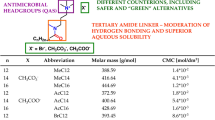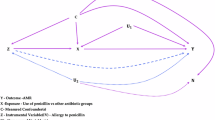Abstract
The agar-plate or the cylinder-plate method of testing the effectiveness of antiseptics and antibiotics is now a well-known laboratory technique; and it is the basis of quantitative estimations of penicillin and of other antiseptics. There is little doubt that the degree of ‘zoning’ obtained is an excellent criterion of a good chemotherapeutic agent, and Fleming1 considers that this test should be so applied. However, recent experiences in my laboratory indicate that this test is not necessarily a good criterion for cation-active antiseptics of the class of quaternary ammonium salts, such as cetyl trimethyl ammonium bromide (‘Cetavlon’) and cetyl pyridinium ohloride (‘Ceepryn’).
Similar content being viewed by others
Article PDF
References
Chem. and Indust., Jan. 20, 1945, p. 18.
Author information
Authors and Affiliations
Rights and permissions
About this article
Cite this article
PHILLIPS, M. Assay of Cation-Active Antiseptics. Nature 160, 55 (1947). https://doi.org/10.1038/160055a0
Issue date:
DOI: https://doi.org/10.1038/160055a0
This article is cited by
-
The effect of agar on the inhibitory activity of phenols
Antonie van Leeuwenhoek (1963)



